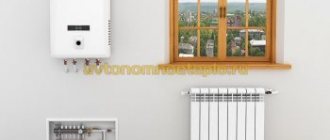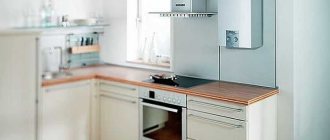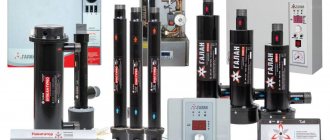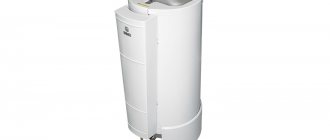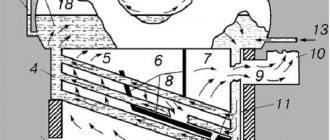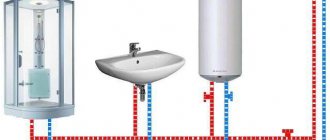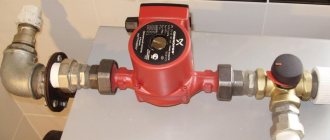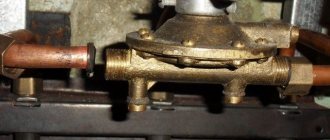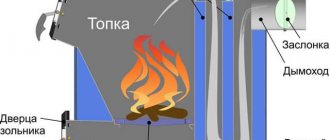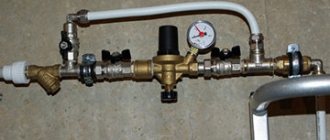Recently, many people have been heating their homes using underfloor heating, which allows for more optimal distribution of heat throughout the living space. Heated floors can be water or electric. A water floor is more difficult to make, so it is more expensive. As for the electric heated floor, it is much easier to install, but the costs of its operation are somewhat higher. If you install the floor yourself, then the water heated floor is more economical, since the costs of its operation are minimal.
Water heated floor system - general description
Floor heating is carried out by coolant. From the name of the system it is clear that the coolant of a water heated floor is water circulating through the pipes. Temperature regulation and circulation control take place in a specially mounted manifold cabinet. The pipes are laid in loops on the base floor and connected to the manifold cabinet.
As you can see in the photo, a manifold cabinet is a heated floor unit in which heated floor pipes are assembled and the flow of coolant is regulated by manifolds with control valves. By the way, not a single construction site, no industrial or residential buildings can do without utilities in the form of pipelines. A simple, ubiquitous water supply and a common gas pipeline are familiar to any resident of the city or countryside. Pipelines for steam and petroleum products are familiar to employees of specialized enterprises.
If there is a pipeline, then you cannot do without special equipment that blocks, regulates flows and distributes the moving flows. This type of equipment is called pipeline fittings. The operation of all pipeline systems depends on its quality. read more about pipeline fittings for various purposes on the website.
The loops of the water heated floor are laid according to two schemes:
1-Bifilar laying system. Otherwise known as “double helix” or “snail”;
2,3-Meander system. In other words, “zigzag” or “snake”.
The most effective laying system is where loops of warm water alternate with cooled water (1.3 in the figure)
Depending on the type of coating covering the pipeline, water heated floors are divided into concrete heated floors, as well as polystyrene systems and wooden floor heating systems. In a concrete heated floor, the system pipeline is closed with a “wet” screed.
Water heated floors are not a universal floor heating system and have some limitations when used.
Pipe layout
For laying, you can use pipes made of heat-stabilized and cross-linked polyethylene with an oxygen barrier with a diameter of 16 mm. It is not recommended to take a larger diameter, since such a pipe will be difficult to pull through during installation. The pipe diameter may be larger if the circuit length is more than 100 m.
Pipe can be produced using various technologies, thanks to which a wide range is available on the market. The main criteria for choosing a pipe will be the material of manufacture, quality and optimal price. Pipes made of cross-linked polyethylene are more elastic and have a high cross-link density. These pipes are based on reinforced polymer. PE-RT pipes are more manageable during installation, but if broken, they cannot be restored.
The thickness of the screed is on average from 5 to 10 cm. These are approximate values, taking into account the fact that measurements are taken from the insulation. With lower values, the likelihood that cracks may appear on the screed after installation increases, so it is highly undesirable to save on this.
A screed that is too thick is also not recommended, since in this case it will take a long time to warm up and take a long time to cool down. This will make it difficult to regulate the temperature at home. The optimal thickness of the screed is 5-6 cm above the pipes. You can pour the screed at the stage of pouring the foundation, or you can wait a while for the floor to settle a little.
Limitations when using water heated floors
- In city apartments with centralized heating, the installation of water heated floors is prohibited.
- This is due to an increase in the hydraulic resistance of the system and a high probability of damage to the heating pipes after water hammer in the centralized heating system. However, in some series of modern new buildings a separate main pipeline has been designed for the installation of water heated floors.
- First of all, heating a room using water heated floors is used for private houses with an individual water supply system. But here, too, a water-heated floor can be used either for comfortable or general heating.
Thermal insulation layers
The design of a water heated floor includes several layers of thermal insulation, each of which has its own purpose:
- Waterproofing material. A layer with such material is necessary to prevent soil water from penetrating into the room;
- Polyethylene. A layer of polyethylene prevents water from being absorbed into the insulation, and also does not allow water to go into the ground;
- Insulation. A layer with insulation is needed to prevent heat leakage into the ground;
- Concrete screed. The screed layer is intended for filling the supplied system;
- Substrate. This layer is laid on the screed.
These layers are of great importance when installing water heated floors. The final thermal insulation of the coating depends on the quality of the materials used and their subsequent installation. It is important not only to choose the right materials, but also to install the floor without errors, taking into account the characteristics of a particular climate.
“Comfortable” and “heating” water heated floor
A “comfortable” water heated floor heats the floor and is used as an additional room heating system. The main heating is provided by heating radiators. For a comfortable heated floor, the water temperature in the system must be maintained constant. This type of water temperature control is called “thermostatic”.
The “heating” water heated floor has the function of complete and only heating of the room. With such a system, the temperature of the coolant (water) should vary depending on the ambient temperature. This type of adjustment is called “weather-dependent”.
Basic elements of heated floors
So, a water heated floor is made of the following elements:
- Rough coating. A thick film is laid on top of it;
- Insulation. Covered with a loose film;
- Mesh poppy. Improves screed reinforcement and fixes the pipe during laying;
- Screed. Necessary for leveling the surface, preventing heat loss and bending of pipes;
- Pipe. It comes in different thicknesses and diameters; it is best to choose a pipe with an oxygen barrier;
- Collector. Serves to ensure the flow of coolant into the floor heating system;
- Tile. The optimal solution is ceramic tiles, which are wear-resistant, hard and absorb moisture well, but other coatings can be used.
Here are the main elements that make up the design of a water-heated floor. Their correct distribution among layers ensures good thermal insulation. It is important to take into account the optimal values for the length and thickness of each element, as well as pay attention to the materials of manufacture.
The rough coating first needs to be leveled. This is a mandatory step when installing a water heated floor. If this is not done, then the thermal insulation slabs will not fit tightly to the base, as a result of which, after some time, subsidence may appear in some places. This will subsequently lead to the appearance of cracks in the screed.
The total thickness of the heated floor is about 14-20 cm. At the same time, the parameters of ceramic tiles with glue are approximately 2-3 cm, the thickness of the screed over the pipes is about 6 cm, the pipe with poppy mesh is approximately 2 cm, and the insulation itself has an average thickness of 8 -10 cm (it is optimal to lay 2 sheets of 5 cm each). These values are arbitrary and may vary slightly up or down.
The main components of a water heated floor: screed, water circuit pipe, layers of thermal insulation and the floor covering itself. Special attention is paid to thermal insulation layers.
General principle of operation of water heated floors
Water heated floors are low-temperature floor heating systems. The temperature of the coolant (water) should be 35-45°C.
The water in the water heated floor system moves along a closed circuit, gradually cooling in the floor loops. Water comes from the main at a temperature of 80-85°C. In the manifold cabinet of the heated floor, the hot coolant is mixed with cooled water returning from the system loops.
A pumping and mixing unit (1) is used to mix hot and cold coolant. To shut off the water circulation, a collector block (3) is used, with rows of cold and “hot” shut-off valves (bypasses).
A balancing valve (2) is used to regulate the heat output. To maintain the set temperature, a thermal head (4) is used, which receives temperature data from a temperature sensor.
To automatically control the system, you can install servo drives and room thermostats. Servo drives and thermostats work in pairs.
When the water supply from the main stops, the circulation of the coolant continues thanks to the opening of the bypass valve. The coolant circulates in “cold mode” through the free bypass (shut-off valve) of the collector block.
More details about the operation of the manifold cabinet, installation technology and the design of the “pie” of a concrete water heated floor in the following articles in the “Water Heated Floor” series.
©opolax.ru
Other articles in this section
- Advantages and disadvantages of solid fuel boilers
- Concrete underfloor heating system: device features, technology
- Three applications of heating cable: heating of roof, floor and pipes
- Types of cables for heated floors
- Polystyrene underfloor heating system
Popular component manufacturers
When installing a water-heated floor, choosing the necessary components is not difficult, since most manufacturers of such systems also produce components for them. In addition, some manufacturers have begun to produce mixing units, which eliminates the need for users to install a separate circulation pump.
The most trusted manufacturers that produce polymer pipes with a service life of more than 50 years include:
- "Valtec"
- "De Dietrich";
- "Acv";
- "Ctc";
- "Buderus".
In addition, these companies produce control panels, which allows you to monitor the operation of the system anywhere in the house.
In conclusion, we can say that in terms of efficiency, water-heated floors are superior to other types of heating devices. After all, the resource is not wasted on heating the air under the ceiling.
When you decide to install heated floors, carefully study all possible installation schemes for these systems, as well as how water heated floors work in an apartment or house, in order to choose the best option for yourself.
Types and possible places of purchase in Moscow
First, let's look at the list of types of heating, and then, based on it, we will analyze each item in detail.
- Cable-based electric floors are:
- with single-core wires;
- with two-core cables;
- with self-regulating cables;
- Heating resistive mats;
- Infrared sheets are:
- in the form of a film;
- in the form of infrared rod mats;
These were electric types of heating systems, but there are also designs based on the circulation of hot water:
- Water heating systems.
All of the above types can be purchased without problems in stores and online stores in Moscow. The same can be said regarding installation.
So, if you do not have installation skills, then the city is full of services and specialists who will install any type of system for you for a fee. This will significantly save your money and time.
Installation procedure
Let's consider laying an electric heated floor without a screed. This is an option that works for most varieties.
Procedure:
- Complete subfloor cleaning. Remove the old flooring and plank flooring (you don’t have to remove it, but the floor level will be changed). Inspect the surface, remove all fasteners and other parts.
- Seal cracks and potholes in the subfloor.
- Lay a layer of thermal insulation. You can cover the room with penoplex, or use ready-made mats for heated floors. They are needed only for the heating cable; all rolled varieties are placed on an even layer of heat insulation.
- Lay the fiberglass mesh, fixing it to the insulation with double-sided tape.
- The heating cable is laid according to a pre-selected pattern.
- Connect the cable and temperature sensor to the control unit installed on the wall in close proximity to the heating element (this allows you to reduce the resistance of the wire).
- Apply power and check system operation. If there are no complaints, sheet materials (plywood, chipboard or OSB) are laid.
- Laying the floor covering.
The general scheme of work is presented. There may be additional procedures that have to be performed in rooms with complex configurations or problems with the subfloor.
Conditions and rules that are important to follow
Whatever the cost of a water heated floor, the purchase is advisable only when certain conditions and rules are observed.
Problems will arise if they are not followed: either the floor will be too hot, or the service life of the pipes will be halved. These are just a few of the undesirable consequences that imprudence entails. Rooms for different purposes require different temperatures:
- in the bedroom - 18 degrees;
- in the bathroom - 25 degrees;
- in the hall - 22 degrees;
- in the kitchen - 20 degrees.
Servo
creates a suitable temperature for each room separately. The device is installed on the return collector sockets. Such equipment smoothly opens and closes passages in the circuits at the command of room thermostats.
Rules that will help you avoid mistakes when installing heated floors:
- Do not exceed a certain number of circuits that are connected to the collector;
- Do not exceed the maximum length of contours;
- Pipe diameter - no more than 80 or 20 mm;
- Before operation, you need to calculate the appropriate pump power;
- Make an installation plan in advance and prepare all the necessary tools.

